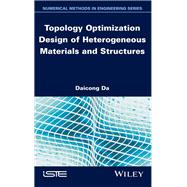
Topology Optimization Design of Heterogeneous Materials and Structures
by Da, Daicong-

Free Shipping on All Orders!
*excludes Marketplace items.
Buy New
Rent Textbook
Rent Digital
Used Textbook
We're Sorry
Sold Out
How Marketplace Works:
- This item is offered by an independent seller and not shipped from our warehouse
- Item details like edition and cover design may differ from our description; see seller's comments before ordering.
- Sellers much confirm and ship within two business days; otherwise, the order will be cancelled and refunded.
- Marketplace purchases cannot be returned to eCampus.com. Contact the seller directly for inquiries; if no response within two days, contact customer service.
- Additional shipping costs apply to Marketplace purchases. Review shipping costs at checkout.
Summary
Author Biography
Table of Contents
Introduction ix
Part 1. Multiscale Topology Optimization in the Context of Non-separated Scales 1
Chapter 1. Size Effect Analysis in Topology Optimization for Periodic Structures Using the Classical Homogenization 3
1.1. The classical homogenization method 4
1.1.1. Localization problem 4
1.1.2. Definition and computation of the effective material properties 7
1.1.3. Numerical implementation for the local problem with PER 9
1.2. Topology optimization model and procedure 10
1.2.1. Optimization model and sensitivity number 10
1.2.2. Finite element meshes and relocalization scheme 12
1.2.3. Optimization procedure 14
1.3. Numerical examples 16
1.3.1. Doubly clamped elastic domain 17
1.3.2. L-shaped structure 19
1.3.3. MBB beam 24
1.4. Concluding remarks 25
Chapter 2. Multiscale Topology Optimization of Periodic Structures Taking into Account Strain Gradient 29
2.1. Non-local filter-based homogenization for non-separated scales 30
2.1.1. Definition of local and mesoscopic fields through the filter 30
2.1.2. Microscopic unit cell calculations 33
2.1.3. Mesoscopic structure calculations 39
2.2. Topology optimization procedure 41
2.2.1. Model definition and sensitivity numbers 41
2.2.2. Overall optimization procedure 42
2.3. Validation of the non-local homogenization approach 43
2.4. Numerical examples 45
2.4.1. Cantilever beam with a concentrated load 46
2.4.2. Four-point bending lattice structure 52
2.5. Concluding remarks 55
Chapter 3. Topology Optimization of Meso-structures with Fixed Periodic Microstructures 57
3.1. Optimization model and procedure 58
3.2. Numerical examples 61
3.2.1. A double-clamped beam 61
3.2.2. A cantilever beam 64
3.3. Concluding remarks 66
Part 2. Topology Optimization for Maximizing the Fracture Resistance 67
Chapter 4. Topology Optimization for Optimal Fracture Resistance of Quasi-brittle Composites 69
4.1. Phase field modeling of crack propagation 71
4.1.1. Phase field approximation of cracks 71
4.1.2. Thermodynamics of the phase field crack evolution 72
4.1.3. Weak forms of displacement and phase field problems 75
4.1.4. Finite element discretization 76
4.2. Topology optimization model for fracture resistance 78
4.2.1. Model definitions 78
4.2.2. Sensitivity analysis 80
4.2.3. Extended BESO method 85
4.3. Numerical examples 87
4.3.1. Design of a 2D reinforced plate with one pre-existing crack notch 88
4.3.2. Design of a 2D reinforced plate with two pre-existing crack notches 93
4.3.3. Design of a 2D reinforced plate with multiple pre-existing cracks 96
4.3.4. Design of a 3D reinforced plate with a single pre-existing crack notch surface 98
4.4. Concluding remarks 101
Chapter 5. Topology Optimization for Optimal Fracture Resistance Taking into Account Interfacial Damage 103
5.1. Phase field modeling of bulk crack and cohesive interfaces 104
5.1.1. Regularized representation of a discontinuous field 104
5.1.2. Energy functional 106
5.1.3. Displacement and phase field problems 108
5.1.4. Finite element discretization and numerical implementation 111
5.2. Topology optimization method 114
5.2.1. Model definitions 114
5.2.2. Sensitivity analysis 116
5.3. Numerical examples 119
5.3.1. Design of a plate with one initial crack under traction 120
5.3.2. Design of a plate without initial cracks for traction loads 123
5.3.3. Design of a square plate without initial cracks in tensile loading 125
5.3.4. Design of a plate with a single initial crack under three-point bending 128
5.3.5. Design of a plate containing multiple inclusions 130
5.4. Concluding remarks 133
Chapter 6. Topology Optimization for Maximizing the Fracture Resistance of Periodic Composites 135
6.1. Topology optimization model 136
6.2. Numerical examples 138
6.2.1. Design of a periodic composite under three-point bending 138
6.2.2. Design of a periodic composite under non-symmetric three-point bending 146
6.3. Concluding remarks 151
Conclusion 153
References 157
Index 173
An electronic version of this book is available through VitalSource.
This book is viewable on PC, Mac, iPhone, iPad, iPod Touch, and most smartphones.
By purchasing, you will be able to view this book online, as well as download it, for the chosen number of days.
Digital License
You are licensing a digital product for a set duration. Durations are set forth in the product description, with "Lifetime" typically meaning five (5) years of online access and permanent download to a supported device. All licenses are non-transferable.
More details can be found here.
A downloadable version of this book is available through the eCampus Reader or compatible Adobe readers.
Applications are available on iOS, Android, PC, Mac, and Windows Mobile platforms.
Please view the compatibility matrix prior to purchase.
